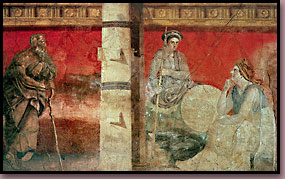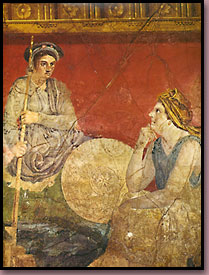Many nationalities lived in the Seleucid kingdom. This is the reason why there existed a social multiformity, which was based on the wilful tolerance of the central authority. The social structure of the kingdom was influenced to a large extent by the policy of the Seleucid dynasty to found Greek cities and dispersed settlements in the kingdom. Certain among these settlements had a military character and were called katoikiai. The promotion of Macedonians and other Greeks to important administrative and military positions contributed to this situation, which resulted in the creation of a ruling class with Greek character, where the representation of natives was limited.
This policy had been inaugurated in the East by Alexander, applied by Antigonus Gonatas and expanded by Seleucus I and his successors Antiochus I and Antiochus II. These Greek communities were founded in the regions stretching from Asia Minor, Syria, Mesopotamia, Parapotamia and Babylonia as far as Bactria and Sogdiana. In certain cities, such as Sardis, a large Greek community already existed even before the time of Seleucus, while others that were inhabited by natives, such as Hierapolis, were strengthened, in terms of population, by Macedonians.
The reasons for which the Seleucids applied the Greek immigration in their kingdom should be traced in military and political expediency, with the purpose of creating a solid basis in order to rule such an extensive kingdom. The installation of Macedonian soldiers in the katoikiai ensured a manpower ready at any moment to reinforce the main troop. The inhabitants of the new cities maintained a close relationship with the king, on whom they depended to some degree to obtain the means for their survival.
A question of particular interest is whether the Seleucids through the policy of immigration, aimed to Hellenize their kingdom and unify it through the prevalence of Greek institutions and the Greek way of living. Greek immigration during the Hellenistic period, like colonization in earlier times, inevitably brought about the Hellenization as a result of a natural procedure. This was beyond the will and expectations of the Greeks who settled in these new places. In the Seleucid kingdom -as in the rest of the Hellenistic kingdoms- the coexistence of Greeks with other peoples led to a mutual influence in the way of living and thinking, as well as to the embracing of new elements from all population groups.
| introduction | kingdoms | demography | structures | Greek society |
Note: Click on the small photo to enlarge it.

01. The Seleucid kingdom

02. Wall-painting from the villa of P. Fannius Sinistor in Boscoreale. According to scholars, it depicts the royal Macedonian family. Photo: Antigonus Gonatas and his mother Phila attend the tuition of the cynic philosopher Menedemus.
